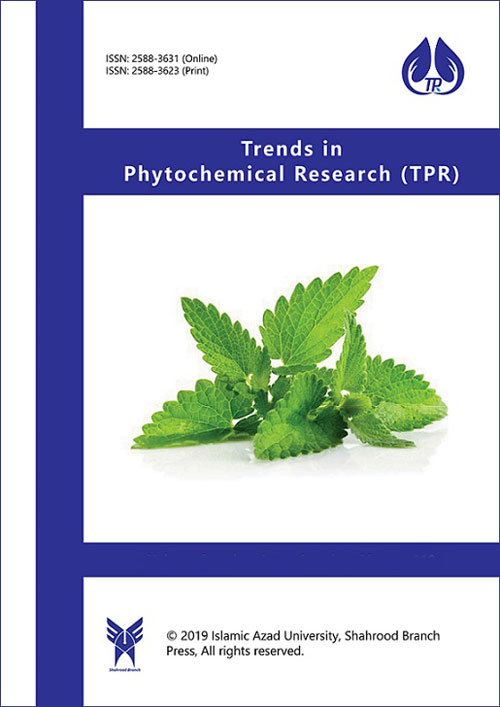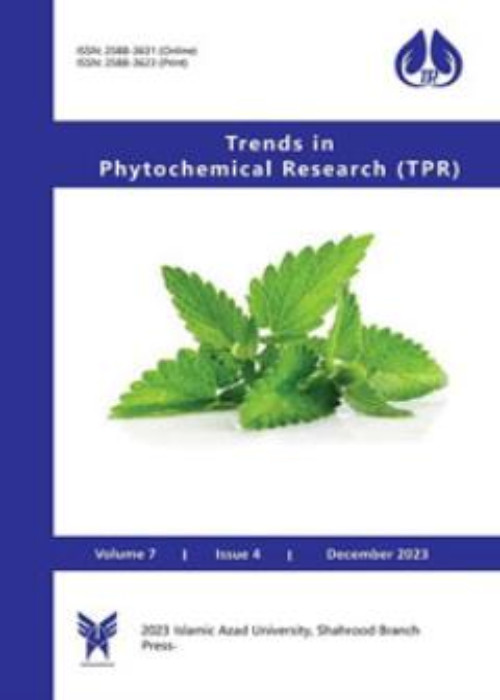فهرست مطالب

Trends in Phytochemical Research
Volume:3 Issue: 4, Autumn 2019
- تاریخ انتشار: 1398/10/09
- تعداد عناوین: 6
-
Pages 231-242
Myrtle is an aromatic and medicinal shrub growing wild in the Mediterranean regions. The objective of this study was to determine qualitative and quantitative morphological characteristics and to analyze the biochemical composition of two wild Tunisian myrtle populations from Bizerte (BM) and Haouaria (HM). These two populations presented the same vegetative characters but with some morphological differences such as the bigger size of BM fruits and leaves. The biochemical characterization revealed that there was an increase in the production of phenols during flowering in both populations, and there was a significant variation in their levels in the various organs. The phenolic fraction of myrtle leaf and the fruit was rich in tannins while the stem was rich in flavonoids. Methanol extracts of different myrtle parts, especially leaf, presented strong antioxidant activities.
-
Pages 243-250
A multivariate analysis was performed on sunflower, poppy and pumpkin seeds based on the analysis of 18 elements including Al, As, B, Ba, Ca, Cd, Cu, Fe, K, Mg, Mn, Na, P, Pb, Si, Sr, Ti, and Zn which were quantified using microwave induced plasma optical emission spectrometry (MIP-OES). To avoid geographical effects, all samples were collected from the same region -San Luis province, Argentina- from 2016 to 2017. In order to determine differences in the mineral profiles as well as to get information from its mineral status, principal component analysis (PCA) was applied. In accordance with this study, toxic elements as pb, cd and as were not detected in the analyzed species, which is a remarkable point compared with other regions around the world. Furthermore, high levels of non-essential nutrients (Al, Ba and Sr) as well as those considered as beneficial non-essential nutrients (Si and Ti) were found in poppy. Applying multivariate analysis -performed by principal components analysis, PCA- it was possible to discriminate groups of seeds according to their botanical origins. Furthermore, PCA allowed inferring about the effect on seed quality due presence of Al, Ba or Sr, as well as the selectivity mechanisms of mineral uptake and filling seed and the differential performance of seeds for initial plant growth -due Si and Ti content- on the three studied species. For these reasons, multivariate analysis has been useful as an informative tool for ionomic and plant development studies.
Keywords: Edible seeds, Elemental analysis, Toxic elements, MIP-OES, PCA -
Pages 251-260
Edible flowers represent an important source of biologically active compounds with positive effects on consumer health. In fact, they contain high quantities of natural antioxidants and have been used since ancient times not only to prepare traditional recipes but also as a remedy against some common illnesses. In the current report, the extracts of ten Mediterranean edible flowers were analyzed to determine their relevant vitamin C, chlorophylls, carotenoids, proanthocyanidins, flavonoids, anthocyanins and total phenolics contents. They were also assayed in vitro for inhibitory effects on digestive enzymes relevant to carbohydrates metabolism and for anti-proliferative activity on CaCo2 colon cancer cell line. Accordingly, the extracts inhibited the a-glucosidase activity in a dose-dependent manner. In addition, half-maximal inhibitory concentration (IC50) ranged from 12.5 ± 1.9 to 132 ± 3.2 mg/mL, while for the anti-proliferative activity IC50 values varied from 24.26 ± 4.5 to 106.3 ± 5.7 mg/mL. In view of the obtained results, the use of these flowers provides important functional ingredients as well as contributing to the realization of delicate and more appealing flavor recipes.
Keywords: Anti-proliferative, Anti-alfa-glucosidase, Edible flowers, Polyphenols -
Pages 261-274
Caffeine is a stimulant alkaloid found in aerial parts of many hot beverages, including coffee and tea. Due to its health impact, quantification of caffeine level in coffee is of paramount importance for consumers and traders, as well. Therefore, this study was designed to determine the caffeine content in coffee beverage prepared from coffee beans, pulp and leaves using high performance liquid chromatography coupled with a reverse phase C8 column and UV-detector. In this study, caffeine sample was extracted from coffee beans, pulp and leaves with boiled distilled water followed by solvent partition with chloroform. The extracted caffeine samples were analyzed alongside caffeine standard solutions over the concentration range of 5-25 μg/mL. For quantitative purposes, the standard caffeine gave an equation of Y=1270560x + 986903 (R2 = 0.998) and the retention time of 1.84 ± 0.01 min. In parallel to the standard caffeine solution, peak area of caffeine contents in 20 μL extracted caffeine samples of 2.5 g coffee powder in 100 mL of distilled water coffee beverage were registered. By using the peak area, caffeine concentration in injected sample and its concentration in the total sample solution was calculated. The percentage masses of caffeine (w/w%) in the original coffee samples were 1.30 ± 0.11% for beans, 0.90 ± 0.11% for pulp and 0.65 ± 0.10% for leaves. These results of caffeine contents in coffee beans in Wollega zone show high caffeine contents when compared with previously reported coffee beans (1.01 ± 0.04-1.19 ± 0.02%) of other parts of Ethiopia using UV/Vis. spectrophotometric technique.
Keywords: Caffeine, Coffee beans, Coffee leaves, Coffee pulp, HPLC -
Pages 275-286
Premna mucronata Roxb. commonly known as agyon, is a plant of family Lamiaceae. This study dealt with the phytochemical analysis of leaves essential oil of Premna mucronata Roxb. (PMLO) using GC/MS technique and screening of its antioxidant activity using 2,2-diphenyl-1-picrylhydrazyl(DPPH), metal chelating and reducing power assays, anti-inflammatory activity using in-vitro albumin denaturation assay and antibacterial activity using well diffusion method against pathogenic bacterial strains Escherichia coli and Staphylococcus aureus. The phytochemical analysis of PMLO revealed the presence of over 71 compounds. 3-octanone was found to be the major constituent that accounts for 23.6% of the total oil composition. The other major constituents identified were ethyl-hexanol (13.9%), 1-octen-3-ol (9.6%), linalool (5.5%), methyl salicylate (2.9%) and E-caryophyllene (2.9%). It was found that PMLO possessed antioxidant activity in terms of DPPH (IC50=11.18±0.03 µg/mL), metal chelating (IC50=18.82±0.46 µg/mL), and reducing power activities (IC50=21.69±0.02 µg/mL) and in-vitro anti-inflammatory activity was also shown by essential oil with IC50=30.27±0.005 µg/mL. Antibacterial activity of PMLO at higher concentration (1000ppm) showed zone of inhibition of 14.33±0.58mm against E. coli and 14.66±0.58mm against S. aureus. The essential oil of leave P.mucronata contains 3-Octanone, 1-octen-3-ol, ethyl-hexanol, linalool, and have antioxidant, anti-inflammation and antibacterial acitivities.
Keywords: Premna mucronata, 3-octanone, Antioxidant, Anti-inflammatory, Antibacterial -
Pages 287-296
Three flavonoids, quercetin 3-O-β-D-glucoside (1), quercetin 3-O-α-D-arabinoside (2) and kaempferol 3-O-β-D-galactoside (3) were isolated from the methanol leaf extract of Annona mucosa. Their structures were determined using physical and spectroscopic methods. compound 1 showed the highest activity against both S. zeamais and P. truncatus with LC50 values of 20.891 μg/ml and 22.241μg/ml, respectively though lower than the activity of deltamethrine a commercial insecticide used as a positive control. Compounds 2 and 3 gave moderate toxicities with LC50 values of 21.745 μg/ml and 24.926 μg/ml for compound 2 and 29.260μg/ml and 24.241μg/ml for compound 3 when tested against S. zeamais and P. truncates, respectively. compounds 1, 2 and 3 were also tested for anti-feedant activities against S. zeamais and P. truncatus and they exhibited interesting results. The activities were concentration dependent, increasing with increase in concentration. Quercetin 3-O-β-D-glucoside (1) showed the highest activities with AFI50 values 14.856 µg/ml and 16.79 µg/ml against S. zeamais and P. truncatus respectively (Figure 3). This actvity was close to but lower than the activity of azadirachtin a commercial antifeedant that had an activity of AFI50 of 12.146 µg/ml and 12.432 µg/ml against S. zeamais and P. truncates, respectively. Compounds 2 and 3 also exhibited relatively high antifeedant activities with values of AFI50 values 17.257µg/ml and AFI50 19.965µg/ml for compound 2 while values of AFI50 21.599 µg/ml and 20.149 µg/ml were obtained for compound 3 respectively, when tested against S. zeamais and P. truncatus respectively.
Keywords: Annona mucosa, Annonaceae, Antifeedant, Contact toxicity, Flavonol glycosides, Prostephanus truncatus, Sitophilus zeamais


